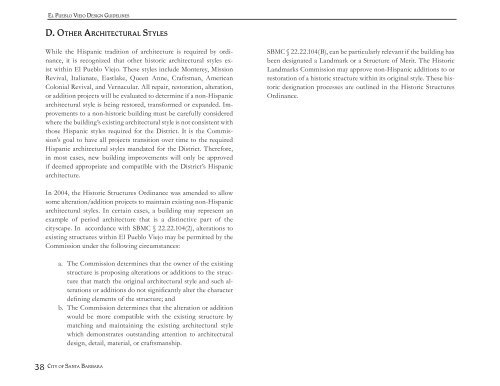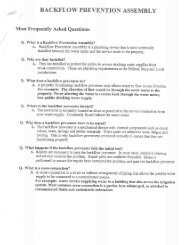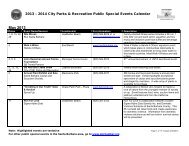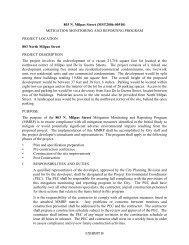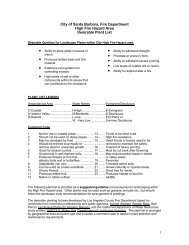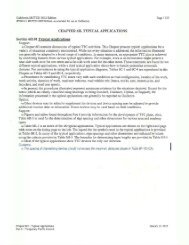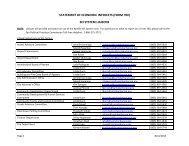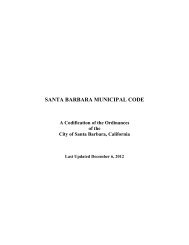El Pueblo Viejo Landmark District - City of Santa Barbara
El Pueblo Viejo Landmark District - City of Santa Barbara
El Pueblo Viejo Landmark District - City of Santa Barbara
- No tags were found...
Create successful ePaper yourself
Turn your PDF publications into a flip-book with our unique Google optimized e-Paper software.
<strong>El</strong> PuEBlo ViEjo DESign guiD<strong>El</strong>inES<br />
d. oTher ArchiTecTurAl sTyles<br />
While the Hispanic tradition <strong>of</strong> architecture is required by ordinance,<br />
it is recognized that other historic architectural styles exist<br />
within <strong>El</strong> <strong>Pueblo</strong> <strong>Viejo</strong>. These styles include Monterey, Mission<br />
Revival, Italianate, Eastlake, Queen Anne, Craftsman, American<br />
Colonial Revival, and Vernacular. All repair, restoration, alteration,<br />
or addition projects will be evaluated to determine if a non-Hispanic<br />
architectural style is being restored, transformed or expanded. Improvements<br />
to a non-historic building must be carefully considered<br />
where the building’s existing architectural style is not consistent with<br />
those Hispanic styles required for the <strong>District</strong>. It is the Commission’s<br />
goal to have all projects transition over time to the required<br />
Hispanic architectural styles mandated for the <strong>District</strong>. Therefore,<br />
in most cases, new building improvements will only be approved<br />
if deemed appropriate and compatible with the <strong>District</strong>’s Hispanic<br />
architecture.<br />
In 2004, the Historic Structures Ordinance was amended to allow<br />
some alteration/addition projects to maintain existing non-Hispanic<br />
architectural styles. In certain cases, a building may represent an<br />
example <strong>of</strong> period architecture that is a distinctive part <strong>of</strong> the<br />
cityscape. In accordance with SBMC § 22.22.104(2), alterations to<br />
existing structures within <strong>El</strong> <strong>Pueblo</strong> <strong>Viejo</strong> may be permitted by the<br />
Commission under the following circumstances:<br />
a. The Commission determines that the owner <strong>of</strong> the existing<br />
structure is proposing alterations or additions to the structure<br />
that match the original architectural style and such alterations<br />
or additions do not significantly alter the character<br />
defining elements <strong>of</strong> the structure; and<br />
b. The Commission determines that the alteration or addition<br />
would be more compatible with the existing structure by<br />
matching and maintaining the existing architectural style<br />
which demonstrates outstanding attention to architectural<br />
design, detail, material, or craftsmanship.<br />
38 <strong>City</strong> <strong>of</strong> <strong>Santa</strong> BarBara<br />
SBMC § 22.22.104(B), can be particularly relevant if the building has<br />
been designated a <strong>Landmark</strong> or a Structure <strong>of</strong> Merit. The Historic<br />
<strong>Landmark</strong>s Commission may approve non-Hispanic additions to or<br />
restoration <strong>of</strong> a historic structure within its original style. These historic<br />
designation processes are outlined in the Historic Structures<br />
Ordinance.


